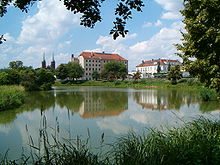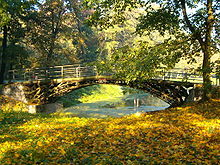Opatówek
| Opatówek | ||
|---|---|---|

|
|
|
| Basic data | ||
| State : | Poland | |
| Voivodeship : | Greater Poland | |
| Powiat : | Kaliski | |
| Gmina : | Opatówek | |
| Area : | 12.20 km² | |
| Geographic location : | 51 ° 44 ' N , 18 ° 14' E | |
| Residents : | 3673 (June 30, 2019) | |
| Postal code : | 62-860 | |
| Telephone code : | (+48) 62 | |
| License plate : | PKA | |
| Economy and Transport | ||
| Street : |
A2 / E30 Berlin – Poznan – Warsaw DK12 Kalisz - Łódź |
|
| Rail route : | Łódź – Ostrów Wielkopolski | |
| Next international airport : | Łódź | |
Opatówek is a town in the powiat Kaliski of the Greater Poland Voivodeship in Poland , with about 3670 inhabitants. It is the seat of the town-and-country municipality of the same name with 10,810 inhabitants (as of June 30, 2019).
geography
The city is ten kilometers southeast of Kalisz , between the Opatówek-Malanów hills. The hills of Chełmce (187 m), Rajsko (177.2 m) and Tłokinia Kościelna (164.7 m) dominate the basins of the Pokrzywnica, Cienia and Swędrnia rivers . The architecture of the place is characterized by neo-Gothic and classicism, the typical architectural style of Opatówek's most successful phase in the 19th century. The landscape of the municipality is very fertile and is characterized by numerous rivers and lakes.
history
Early settlements
After early Celtic colonization, Lugier settled between 400 BC. And 300 AD. The Kalisz ( Calisia ) region was an important trading post on the Amber Road .
Middle Ages and early modern times
Opatówek has belonged to the Archbishops of Gniezno since the 13th century , who presumably gave the place city rights. Archbishop Jarosław Bogoria von Skotniki built a brick church and a castle around 1360. Both buildings stood until the beginning of the 19th century. From 1655 to 1660 the region belonged to Sweden. In 1706 the great decisive battle with 35,000 soldiers between Sweden and Poland against Russians and Saxons took place here around Kalisz. The Polish military leader Stanisław Bogusław Leszczyński was defeated by Saxon soldiers Augustus the Strong and Russian troops. At the end of the 18th century the situation changed again due to the Second Partition of Poland in 1793. Here Poland was divided between Russia, Prussia and Austria. The possessions of the archbishops such as the Posen region and Kalisz and its surroundings were confiscated by the Prussian authorities and fell to Prussia until the Congress of Vienna . From 1807 Józef Zajączek , the future ruler of the Kingdom of Poland , administered the region. During this time many buildings were constructed by the most outstanding architects; In addition, the governor modernized the district structurally and economically, so that an economic boom followed. Napoleon traveled through the Kalisz area with his Grande Armée on his Russian campaign . After the Napoleonic Wars, Poland was placed under Russian administration as a result of the Congress of Vienna . Opatówek was now on the Prussian border from Congress Poland .
Industrial Revolution and the 19th Century
The Polish state significantly improved the framework conditions for investors. Generous loans were refused. As a result, many German entrepreneurs invested in the regions close to the border and set up factories. Particularly noteworthy here are the weaving mills that were looking for cheap labor in foreign countries near the border after the weavers' revolts . Adolf Gottlieb Fiedler , an industrialist from Saxony , came to Opatówek in 1824 and, financed by a Polish loan, founded one of the largest weaving mills in the Kingdom of Poland . He employed 600 workers in Opatówek. The city attracted many immigrants, from simple workers to specialists from Saxony and Bohemia . The city prospered and grew. The weaving mill was one of the most profitable factories of the Fiedlers. Another investment was a wooden toy factory in Opatówek.
In 1870 Opatówek lost its town charter due to economic decline. Nevertheless, the weaving mill existed until the end of the 19th century.
20th century
At the end of the 19th and beginning of the 20th century, the Polish national movement against Prussia and Russia grew in Opatówek as in many other cities in Greater Poland . The brothers Stefan and Agaton Giller should be mentioned here in Opatówek . The various rebellions led by the First World War to the Second Polish Republic . The young democracy came to an abrupt end first with the Sanacja regime and later with Hitler's attack in 1939 . Resistance groups were also formed in the Kalisz district, which now belonged to Litzmannstadt (Łódź), which were usually discovered by the Gestapo . In addition, the German Empire tried to " Germanize " the Polish territories . From 1940 to 1945 Opatówek had the German name Spatenfelde .
After the Second World War, the area went through various changes. During the Gomułka regime from 1956 to 1970, the Kalisz area and the surrounding area increasingly fell into disrepair. The iron curtain and isolation from border trade is an inadequate explanation. The Gierek regime that followed until 1980 invested in the region and ensured an economic upswing. Since the Third Polish Republic in 1990, trade with Germany has increasingly prospered again. In 1998 a major regional reform took place in Poland and Opatówek was assigned as a municipality with 26 localities to the new Powiat Kalisz. On January 1, 2017, Opatówek was restored to town.
In 1998 the garden and agricultural fair “ Pamiętajcie o ogrodach ” took place in the municipality . Both local and national gardeners and fruit growers participated in the exhibition. In 2001 the VII National Summer Olympic Games ( Greater Poland Voivodeship ) took place for young people. Opatówek hosted the rowers and the cyclists. In the summer of 2004, the Szałe artificial lake hosted the Summer Olympics for water sports. In 2006, various international volleyball tournaments were held in the new Opatowek sports hall.
Culture
Architectural monuments
- The neo-Gothic Church of the Sacred Heart of Jesus in Opatówek from the beginning of the 20th century on the foundations of a previous church
- oldest existing cast iron bridge in Poland
- Classicist cloth factory from Adolf Gottlieb Fiedler , today the Opatówek Industrial History Museum
- There are some monuments from Zajączek's time, including the so-called “cake shop”, the palace annex and farm workers' houses.
museum
The Industrial History Museum is the best known cultural institution. It was founded in 1981 in the former cloth factory. One of the most valuable permanent exhibitions is the collection of antique pianos made by Polish companies. The museum is proposed for inclusion on the UNESCO list for the preservation of industrial heritage. Concerts, conferences and various activities are also held here.
Library
The “Giller Brothers” library is Opatówek's general municipal library. It has two branches in Rajsko and in Tłokinia Wielka ; since 1999 she has been the district library in the Kalisz district. The library with a valuable collection of books is completely automated.
education
- a kindergarten
- Primary school : Janusz Kusocinski School
- a grammar school with newly built school buildings
- Stanislaw Mikolajczyk School, a secondary school to prepare for university
- Technical school of agriculture and horticulture
- Wyższa Szkoła Informatyki - a branch of the private university of computer science in Łódź
Events and clubs
- Annual musical festival (Opatówecki Salon Muzyczny) in the old weaving mill
- Sparta football club
- Association of Veterans of the Polish Republic and Former Political Prisoners
- Association of pensioners and disabled people
- Polish Fisheries Association
- 16 volunteer fire brigades with different bands regularly delight those interested with concerts. In 2002 the fire brigade celebrated its 120th anniversary.
tourism
- Narrow-gauge railway from Opatówek to Zbierk, built as a beet railway
- Boat trips on Lake Szałe.
local community
The town itself and 26 villages belong to the town-and-country municipality (gmina miejsko-wiejska) Opatówek.
traffic
One of the advantages of the city is its geographical location between Kalisz , Łódź , Poznan and Wroclaw . The trans-European east-west connection, the E30 motorway , is being built around 30 km to the north . It connects Berlin via Poznan and Warsaw to Moscow.
About 100 km east of Łódź, the large motorway junction is being built with the north-south axes E67 and E75, which will connect the Baltic states with Prague and Athens. The national road 12, which leads from Łęknica in the west to Dorohusk in the Ukraine , runs through the middle of the city and connects Kalisz with Łódź. Opatówek has a train station on the Łódź – Forst (Lausitz) railway line and is directly connected to Łódź and Kalisz. The Opatówek – Żelazków narrow-gauge railway also begins here. A national bike path runs through Opatówek Park.
Personalities
- Adolf Gottlieb Fiedler (1771–1850), entrepreneur in Saxony and Poland
- Agaton Giller (1831–1887), Polish historian, publicist and resistance fighter
- Stefan Giller (1833–1918), Polish writer and teacher in Opatówek
- Ladislaus Pilars de Pilar (1874–1952), Polish writer and industrialist.








